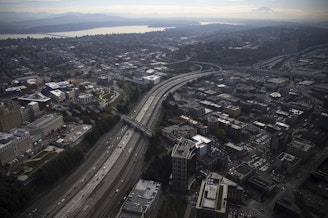Washington lawmakers ponder rules for sidewalk-driving delivery robots
Drones that fly through the sky to deliver packages are taking longer than anticipated to become reality. But wheeled delivery robots that drive down the sidewalk have now arrived, forcing state lawmakers in Olympia to play catch-up and set the rules of the road.Last week, Amazon made a surprise announcement that it has begun testing a fleet of electric delivery robots in an undisclosed neighborhood of Snohomish County, north of Seattle. Another company, Starship Technologies, demonstrated a similar-looking, six-wheeled robot Monday by using it to deliver a sheaf of proposed regulations to a committee chairman in Olympia.
"They are very safe," said Starship's Courtney Edmonds as she minded the picnic cooler-sized robot in the unmapped terrain. "They do have radars and other sensors so it will move out of your way."
According to Edmonds, the Starship robot has nine cameras and a human monitor to watch the fleet. And if someone decides to mess with an individual robot on its delivery route, the bot can send a signal to the human monitor. At that point, the robot could play a voice recording saying, "Hi, we're watching you. Please step away."
Proposed state regulations would limit the small robots to operating on sidewalks and crosswalks, and the machines would have to yield the right of way to pedestrians and bicycles. Idaho authorized delivery robots on sidewalks in 2017, but no companies have taken advantage of the law there yet.
Starship Technologies began making robot deliveries for the cafeteria contractor on the George Mason University campus in Virginia last week. The San Francisco-headquartered company also launched a delivery trial for food in the San Jose, California, area.
Sponsored
"We do packages, groceries, take-out food, anything that will fit in the bin," Edmonds explained. "We hold about 25 pounds of any goods."
She said the top speed for the self-driving robot is 4 mph. During the demonstration at the Washington state capitol, the robot drove slower, essentially at walking pace.
Starship Technologies' David Catania told lawmakers in testimony Monday that the goods carried by the robot are always locked during transport. He said the delivery robot's software sends a text to the intended recipient's smartphone to notify that an order is underway and another text when the robot arrives.
"I sometimes think I'm living in a science fiction novel," remarked Democratic state Rep. Shelley Kloba, who sponsored the proposed robot regulations in the state House of Representatives. "It was concerning to me how they might interact with pedestrians and I'm satisfied how this was worked out."
"I want you all to embrace the future that is right in front of us right now," Kloba urged her fellow members of the House Transportation Committee during an initial hearing on Monday. The suburban Seattle lawmaker praised delivery robots for being quick, quiet and for not taking up space on the roads.
Sponsored
No one testified against authorizing delivery robots during almost-simultaneous state House and Senate hearings Monday. And representatives from Amazon were notably absent. In a blog post announcing its own Scout delivery robot last Wednesday, Amazon said it worked with the Snohomish County Executive’s office to roll out its robot delivery service.
“We’re starting with six Amazon Scout devices, delivering packages Monday through Friday, during daylight hours,” wrote Amazon vice president Sean Scott. “The devices will autonomously follow their delivery route but will initially be accompanied by an Amazon employee.”
Starship Technologies said it would wait for the Legislature to act before expanding operations to Washington state.
"We're not trying to go and ask for forgiveness," said Edmonds. "We want everything to be well thought out and everyone to approve of it." [Copyright 2019 Northwest News Network]



